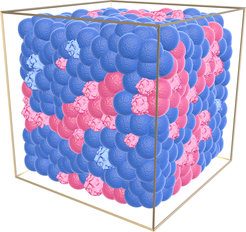Competing cells: Cleaning up after yourself brings benefits
When different cell types compete in a confined space, those which remove debris faster have a better chance to dominate their environment. Researchers from the Max Planck Institute for Dynamics and Self-Organization (MPI-DS) showed in their model that not only a higher net proliferation rate, but also the swift removal of dead cells provides a competitive advantage. They mixed two cell populations only differing in debris removal rate and showed that already after a few generations the population with the higher removal rate starts to dominate the confined space.

Biological organisms and tissues exhibit a constant turnover of cellular material; for instance, to maintain tissue integrity, in case of tumor growth, or for survival of bacterial communities. Intuitively, cell types which are able to proliferate the fastest or die less frequently in a given environment will dominate the confined space within an organism or compartment. “However, these traditional factors do not remain the only ones determining competitive fitness, when taking into account also the debris left behind by dying cells,” Ramin Golestanian, managing director at the MPI-DS says. In their study, the researchers from the department of Living Matter Physics showed that cell types being cleared out faster after death have an advantage that can make them the dominant species.
The scientists created a model to simulate growing cells filling a limited amount of space until mechanical pressure builds up and they reach a state in which division and cell death balance each other. “We wanted to find out what effect dead matter has on the growth of a living system. For this, we designed a simple model that is one of the first to explicitly consider the mechanical effects of dead cells,” Yoav Pollack, first author of the study, describes the approach. “We then analyzed two cell types differing exclusively in the dead-matter removal rate and tracked the proportion of both populations over time. To our excitement, we observed a clear impact on the overall fitness, leading to an advantage for the cell type whose dead cells are removed more quickly,” he explains.
Making room for new cells
At first sight, the removal of dead material might seem disconnected from the formation of new cells – or even counterproductive as it opens up space for other species to invade. But the model shows that by clearing out debris faster, the amount of alive compared to dead cells increases. Overall, this results in a more responsive growth when a species is presented with opportunities for expansion. While this is of little consequence in a homogeneous cell population of the same type, it makes a difference at the interface where different cell types are competing for space. The population with the higher clear-out rate is more likely to have a living cell in the vicinity available to fill vacated space through proliferation. In this way, the higher proportion of living cells gives a competitive advantage.
“In simplified terms, one could say that clearing out and occupying new space is more advantageous than holding on to already occupied space,” comments group leader Philip Bittihn. “In certain cases, this new contribution to competition might also explain why biological tissues and organisms evolved to use specific cell removal mechanisms; ones that are more efficient compared to the alternatives,” he concludes.
As this effect has now been described for the first time, it opens up several new lines of investigation, such as analyzing the extent to which it contributes to the overall fitness in relation to other fitness factors. Yet, the model demonstrates that cleaning up after yourself does indeed pay off for cells.
